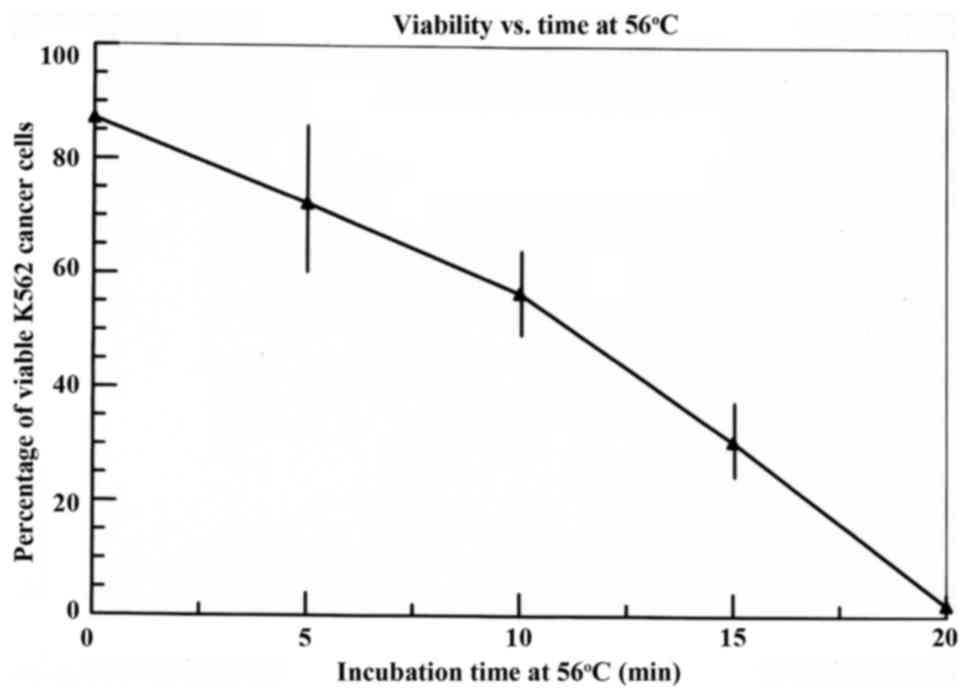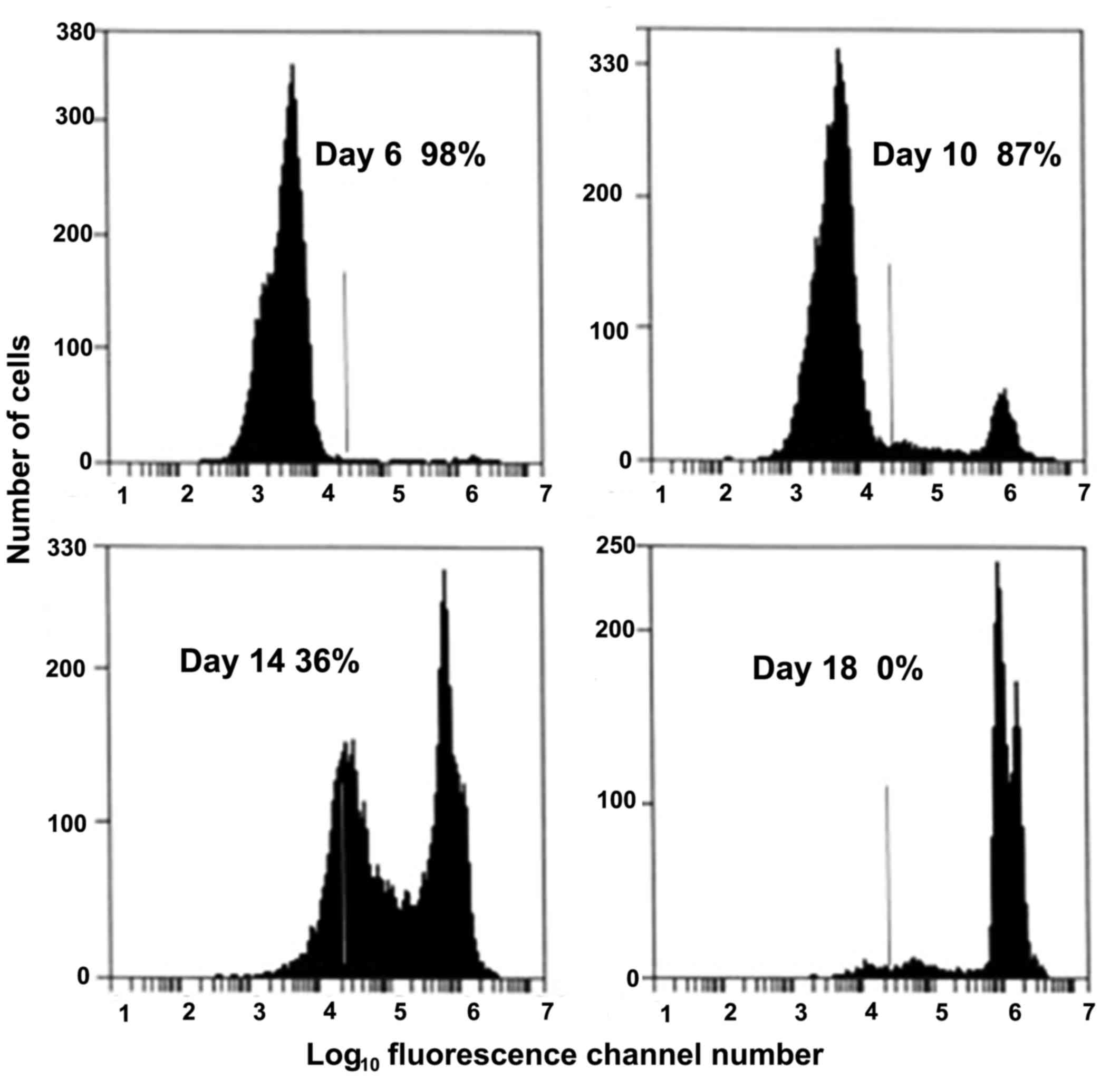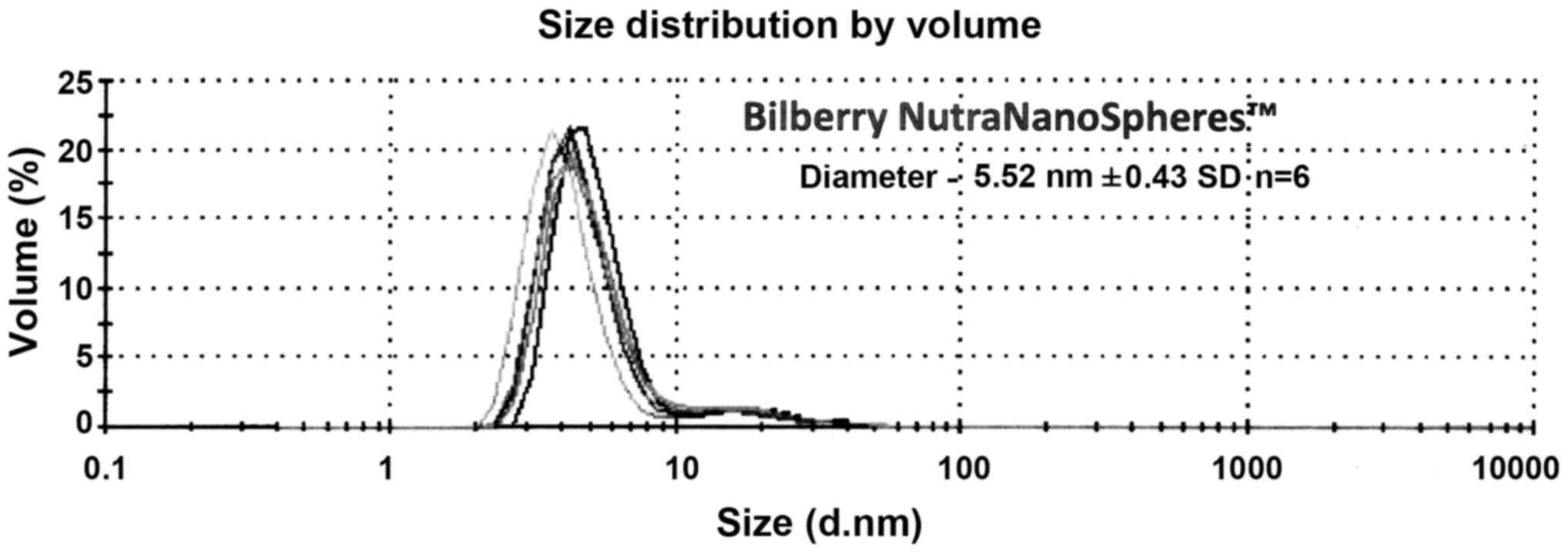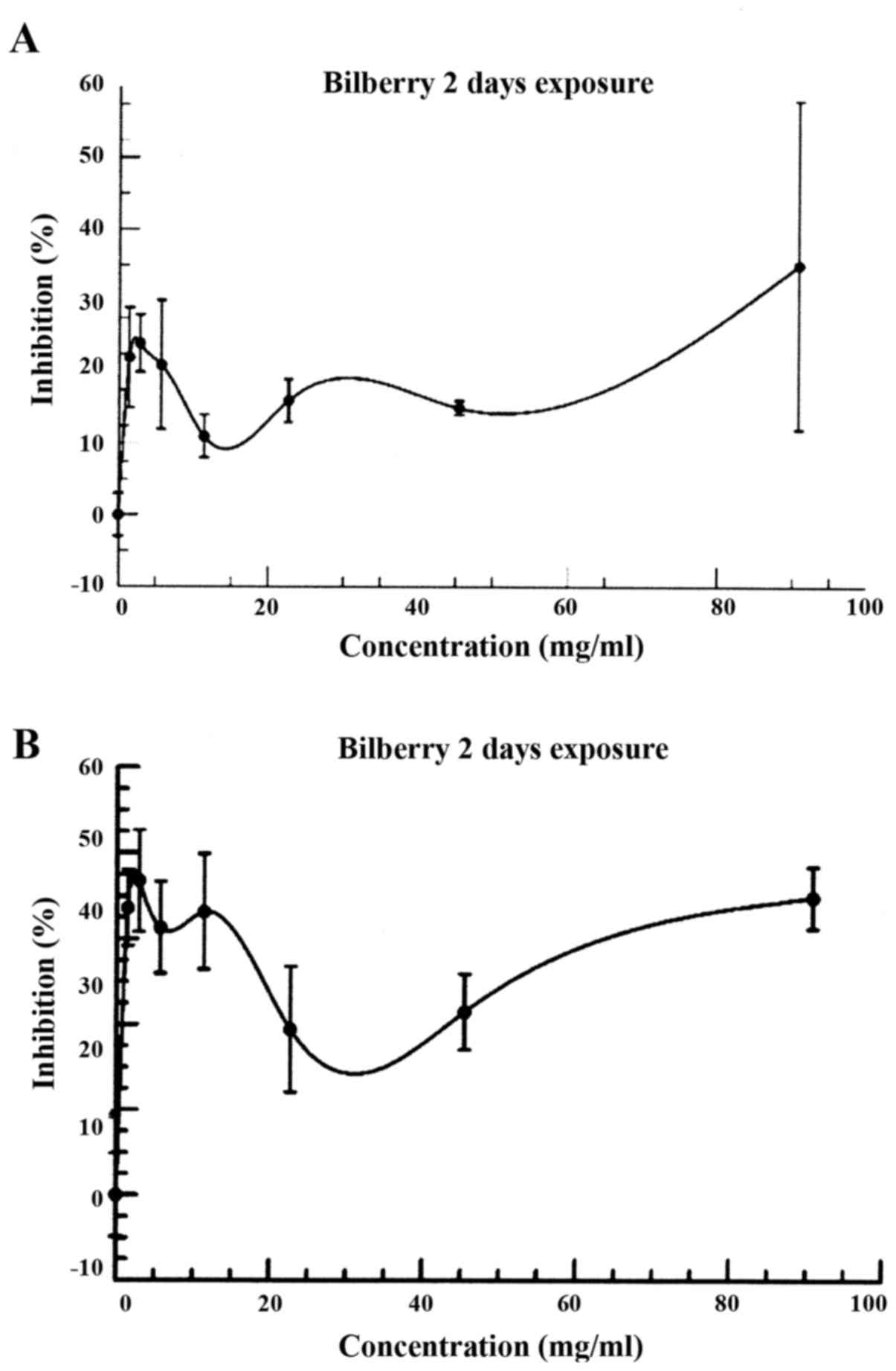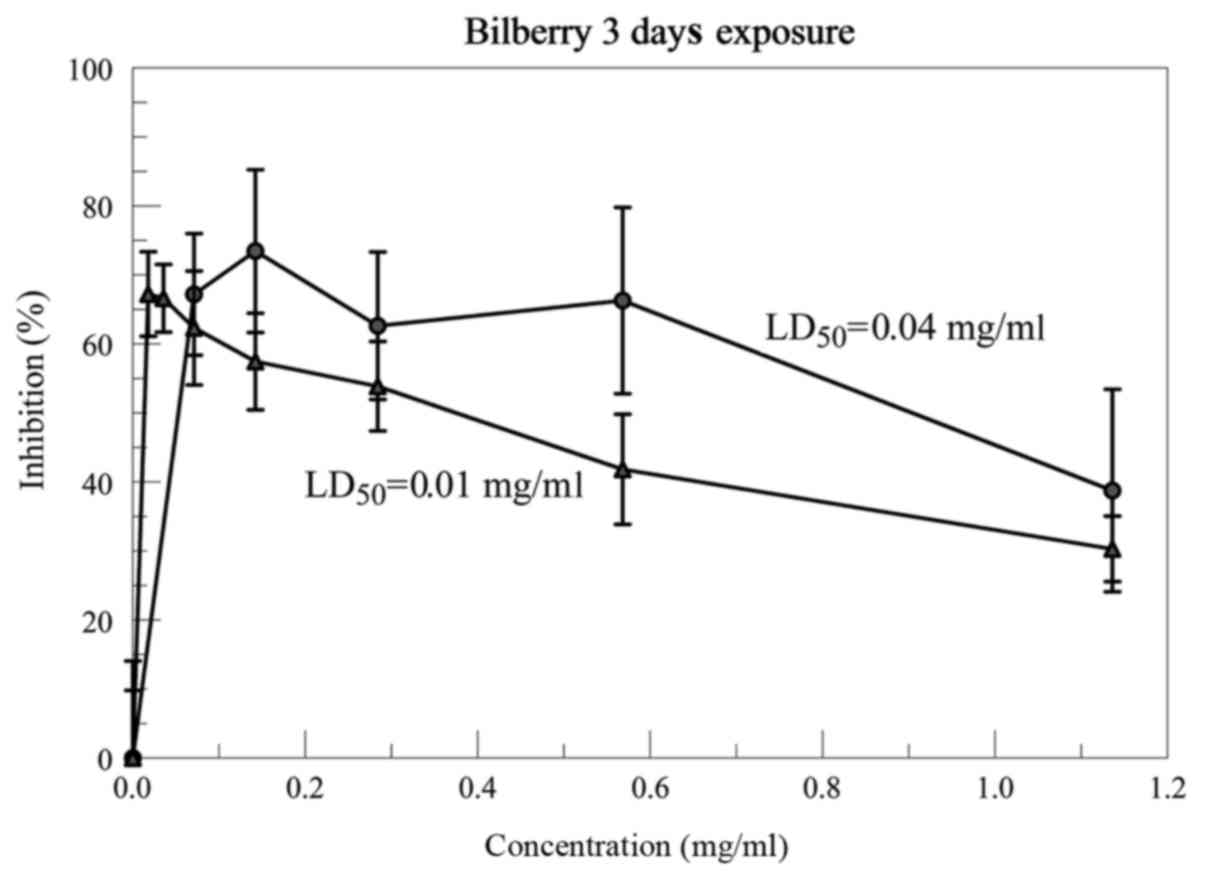|
1
|
Thomasset S, Berry DP, Cai H, West K,
Marczylo TH, Marsden D, Brown K, Dennison A, Garcea G, Miller A, et
al: Pilot study of oral anthocyanins for colorectal cancer
chemoprevention. Cancer Prev Res (Phila). 2:625–633. 2009.
View Article : Google Scholar : PubMed/NCBI
|
|
2
|
Sehitoglu MH, Farooqi AA, Qureshi MZ, Butt
G and Aras A: Anthocyanins: Targeting of signaling networks in
cancer cells. Asian Pac J Cancer Prev. 15:2379–2381. 2014.
View Article : Google Scholar : PubMed/NCBI
|
|
3
|
Alhosin M, León-González AJ, Dandache I,
Lelay A, Rashid SK, Kevers C, Pincemail J, Fornecker LM, Mauvieux
L, Herbrecht R and Schini-Kerth VB: Bilberry extract (Antho 50)
selectively induces redox-sensitive caspase 3-related apoptosis in
chronic lymphocytic leukemia cells by targeting the Bcl-2/Bad
pathway. Sci Rep. 5:89962015. View Article : Google Scholar : PubMed/NCBI
|
|
4
|
Kausar H, Jeyabalan J, Aqil F, Chabba D,
Sidana J, Singh IP and Gupta RC: Berry anthocyanidins
synergistically suppress growth and invasive potential of human
non-small-cell lung cancer cells. Cancer Lett. 325:54–62. 2012.
View Article : Google Scholar : PubMed/NCBI
|
|
5
|
Nguyen V, Tang J, Oroudjev E, Lee CJ,
Marasigan C, Wilson L and Ayoub G: Cytotoxic effects of bilberry
extract on MCF7-GFP-tubulin breast cancer cells. J Med Food.
13:278–285. 2010. View Article : Google Scholar : PubMed/NCBI
|
|
6
|
Misikangas M, Pajari AM, Päivärinta E,
Oikarinen SI, Rajakangas J, Marttinen M, Tanayama H, Törrönen R and
Mutanen M: Three nordic berries inhibit intestinal tumorigenesis in
Min/+ mice by modulating beta-catenin signaling in the tumorand
transcription in the mucosa1. J Nutr. 137:2285–2290.
2007.PubMed/NCBI
|
|
7
|
Mutanen M, Pajari AM, Paivarinta E,
Misikangas M, Rajakangas J, Marttinen M and Oikarinen S: Berries as
chemopreventive dietary constituents-a mechanistic approach with
the ApcMin/+ mouse. Asia Pac J Clin Nutr. 17 Suppl:S123–S125.
2008.
|
|
8
|
Wang Y, Zhao L, Lu F, Yang X, Deng Q, Ji B
and Huang F: Retinoprotective effects of bilberry anthocyanins via
antioxidant, anti-inflammatory and anti-apoptotic mechanisms in a
visible light-induced retinal degeneration model in pigmented
rabbits. Molecules. 20:22395–22410. 2015. View Article : Google Scholar : PubMed/NCBI
|
|
9
|
Walton MC, McGhie TK, Reynolds GW and
Hendriks WH: The flavonol quercetin-3-glucoside inhibits
cyanidin-3-glucoside absorption in vitro. J Agric Food Chem.
54:4913–4920. 2006. View Article : Google Scholar : PubMed/NCBI
|
|
10
|
Sakakibara H, Ichikawa Y, Tajima S, Makino
Y, Wakasugi Y, Shimoi K, Kobayashi S, Kumazawa S and Goda T:
Practical application of flavonoid-poor menu meals to the study of
the bioavailability of bilberry anthocyanins in human subjects.
Biosci Biotechnol Biochem. 78:1748–1752. 2014. View Article : Google Scholar : PubMed/NCBI
|
|
11
|
Walle T: Methylation of dietary flavones
increases their metabolic stability and chemopreventive effects.
Int J Mol Sci. 10:5002–5019. 2009. View Article : Google Scholar : PubMed/NCBI
|
|
12
|
Kim J, Kim CS, Lee YM, Sohn E, Jo K and
Kim JS: Vaccinium myrtillus extract prevents or delays the onset of
diabetes-induced blood-retinal barrier breakdown. Int J Food Sci
Nutr. 66:236–42. 2015. View Article : Google Scholar : PubMed/NCBI
|
|
13
|
Singh S, Netticadan T and Ramdath DD:
Expression of cardiac insulin signaling genes and proteins in rats
fed a high-sucrose diet: Effect of bilberry anthocyanin extract.
Genes Nutr. 11:82016. View Article : Google Scholar : PubMed/NCBI
|
|
14
|
Moshetova LK, Vorob'eva IV, Alekseev IB
and Mikhaleva LG: (Results of the use of antioxidant and
angioprotective agents in type 2 diabetes patients with diabetic
retinopathy and age-related macular degeneration). Vestn Oftalmol.
131:34–44. 2015.(In Russian). View Article : Google Scholar : PubMed/NCBI
|
|
15
|
Asgary S, RafieianKopaei M, Sahebkar A,
Shamsi F and Goli-malekabadi N: Anti-hyperglycemic and
anti-hyperlipidemic effects of Vaccinium myrtillus fruit in
experimentally induced diabetes (antidiabetic effect of Vaccinium
myrtillus fruit). J Sci Food Agric. 96:764–768. 2016. View Article : Google Scholar : PubMed/NCBI
|
|
16
|
Cheng YP, Ke CY, Kuo CC and Lee YJ: Effect
of a complex lutein formula in an animal model for light-induced
retinal degeneration. Chin J Physiol. 59:202–209. 2016. View Article : Google Scholar : PubMed/NCBI
|
|
17
|
Vorob'eva IV and Vorob'eva IV: Current
data on the role of anthocyanosides and flavonoids in the treatment
of eye diseases. Vestn Oftalmol. 131:104–110. 2015. View Article : Google Scholar
|
|
18
|
Ozawa Y, Kawashima M, Inoue S, Inagaki E,
Suzuki A, Ooe E, Kobayashi S and Tsubota K: Bilberry extract
supplementation for preventing eye fatigue in video display
terminal workers. J Nutr Health Aging. 19:548–554. 2015. View Article : Google Scholar : PubMed/NCBI
|
|
19
|
van der Heijden RA, Morrison MC, Sheedfar
F, Mulder P, Schreurs M, Hommelberg PP, Hofker MH, Schalkwijk C,
Kleemann R, Tietge UJ, et al: Effects of anthocyanin and flavanol
compounds on lipid metabolism and adipose tissue associated
systemic inflammation in diet-induced obesity. Mediators Inflamm.
2016:20421072016. View Article : Google Scholar : PubMed/NCBI
|
|
20
|
Takahashi A, Shimizu H, Okazaki Y,
Sakaguchi H, Taira T, Suzuki T and Chiji H: Anthocyanin-rich
phytochemicals from aronia fruits inhibit visceral fat accumulation
and hyperglycemia in high-fat diet-induced dietary obese rats. J
Oleo Sci. 64:1243–1250. 2015. View Article : Google Scholar : PubMed/NCBI
|
|
21
|
Taira T, Yamaguchi S, Takahashi A, Okazaki
Y, Yamaguchi A, Sakaguchi H and Chiji H: Dietary polyphenols
increase fecal mucin and immunoglobulin A and ameliorate the
disturbance in gut microbiota caused by a high fat diet. J Clin
Biochem Nutr. 57:212–216. 2015. View Article : Google Scholar : PubMed/NCBI
|
|
22
|
Hou DX: Potential mechanisms of cancer
chemoprevention by anthocyanins. Curr Mol Med. 3:149–159. 2003.
View Article : Google Scholar : PubMed/NCBI
|
|
23
|
Popović D, Đukić D, Katić V, Jović Z,
Jović M, Lalić J, Golubović I, Stojanović S, Ulrih NP, Stanković M
and Sokolović D: Antioxidant and proapoptotic effects of
anthocyanins from bilberry extract in rats exposed to hepatotoxic
effects of carbon tetrachloride. Life Sci. 157:168–177. 2016.
View Article : Google Scholar : PubMed/NCBI
|
|
24
|
Aqil F, Jeyabalan J, Munagala R, Singh IP
and Gupta RC: Prevention of hormonal breast cancer by dietary
jamun. Mol Nutr Food Res. 60:1470–1481. 2016. View Article : Google Scholar : PubMed/NCBI
|
|
25
|
Roth S, Spalinger MR, Gottier C,
Biedermann L, Zeitz J, Lang S, Weber A, Rogler G and Scharl M:
Bilberry-derived anthocyanins modulate cytokine expression inthe
intestine of patients with ulcerative colitis. PLoS One.
11:e01548172016. View Article : Google Scholar : PubMed/NCBI
|
|
26
|
Nardi GM, Farias Januario AG, Freire CG,
Megiolaro F, Schneider K, Perazzoli MR, Do Nascimento SR, Gon AC,
Mariano LN, Wagner G, et al: Anti-inflammatory activity of berry
fruits in mice model of inflammation is basedon oxidative stress
modulation. Pharmacognosy Res. 8 Suppl 1:S42–S49. 2016. View Article : Google Scholar : PubMed/NCBI
|
|
27
|
Colak N, Torun H, Gruz J, Strnad M,
Hermosín-Gutiérrez I, Hayirlioglu-Ayaz S and Ayaz FA: Bog bilberry
phenolics, antioxidant capacity and nutrient profile. Food Chem.
201:339–349. 2016. View Article : Google Scholar : PubMed/NCBI
|
|
28
|
Jakesevic M, Aaby K, Borge GI, Jeppsson B,
Ahrné S and Molin G: Antioxidative protection of dietary bilberry,
chokeberry and Lactobacillus plantarum HEAL19 in mice subjected to
intestinal oxidative stress by ischemia-reperfusion. BMC Complement
Altern Med. 11:82011. View Article : Google Scholar : PubMed/NCBI
|
|
29
|
Bornsek SM, Ziberna L, Polak T, Vanzo A,
Ulrih NP, Abram V, Tramer F and Passamonti S: Bilberry and
blueberry anthocyanins act as powerful intracellular antioxidants
in mammalian cells. Food Chem. 134:1878–1884. 2012. View Article : Google Scholar : PubMed/NCBI
|
|
30
|
Widén C, Coleman M, Critén S,
Karlgren-Andersson P, Renvert S and Persson GR: Consumption of
bilberries controls gingival inflammation. Int J Mol Sci.
16:10665–10673. 2015. View Article : Google Scholar : PubMed/NCBI
|



